Nursing Assessment for Patient Safety: Mr. Shepherd's Case Study
VerifiedAdded on 2023/06/07
|7
|1855
|408
Practical Assignment
AI Summary
This assignment presents a nursing assessment of an 82-year-old patient, Mr. Shepherd, who was admitted to the hospital with increased confusion and a history of falls. The assessment focuses on identifying and addressing the patient's fall risk and impaired safety. The assignment includes an evaluation of conducted health assessments, such as neurological observations and the Glasgow Coma Scale (GCS), and discusses the need for additional assessments like the Timed Up-and-Go Test. The goal of care is to prevent falls and ensure patient safety through environmental management and patient reorientation. The assignment also provides a progress note detailing the patient's condition, vital signs, and recommendations for wound care, blood pressure management, and supportive self-care. The assessment highlights the importance of evidence-based nursing actions and a comprehensive care plan to improve patient outcomes.
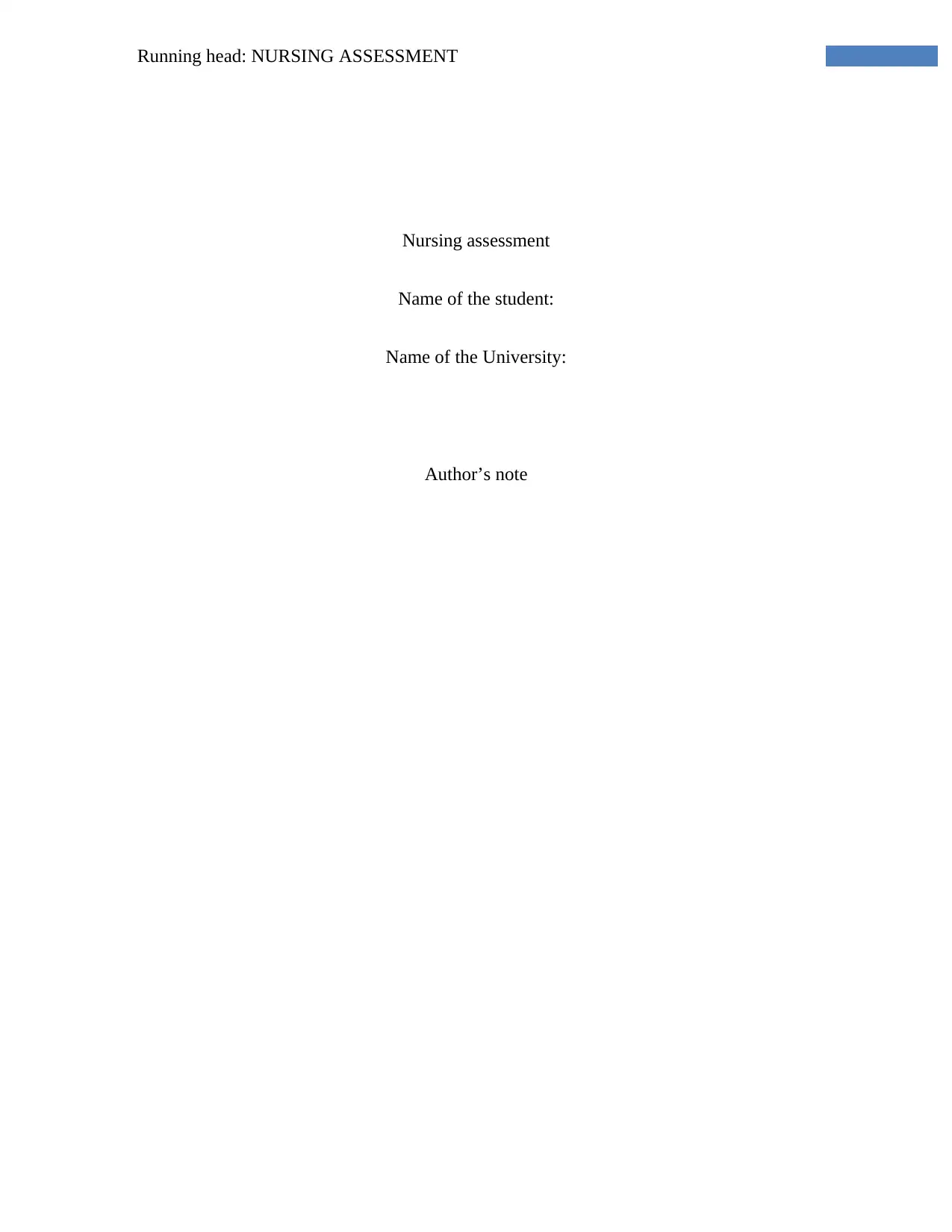
Running head: NURSING ASSESSMENT
Nursing assessment
Name of the student:
Name of the University:
Author’s note
Nursing assessment
Name of the student:
Name of the University:
Author’s note
Paraphrase This Document
Need a fresh take? Get an instant paraphrase of this document with our AI Paraphraser
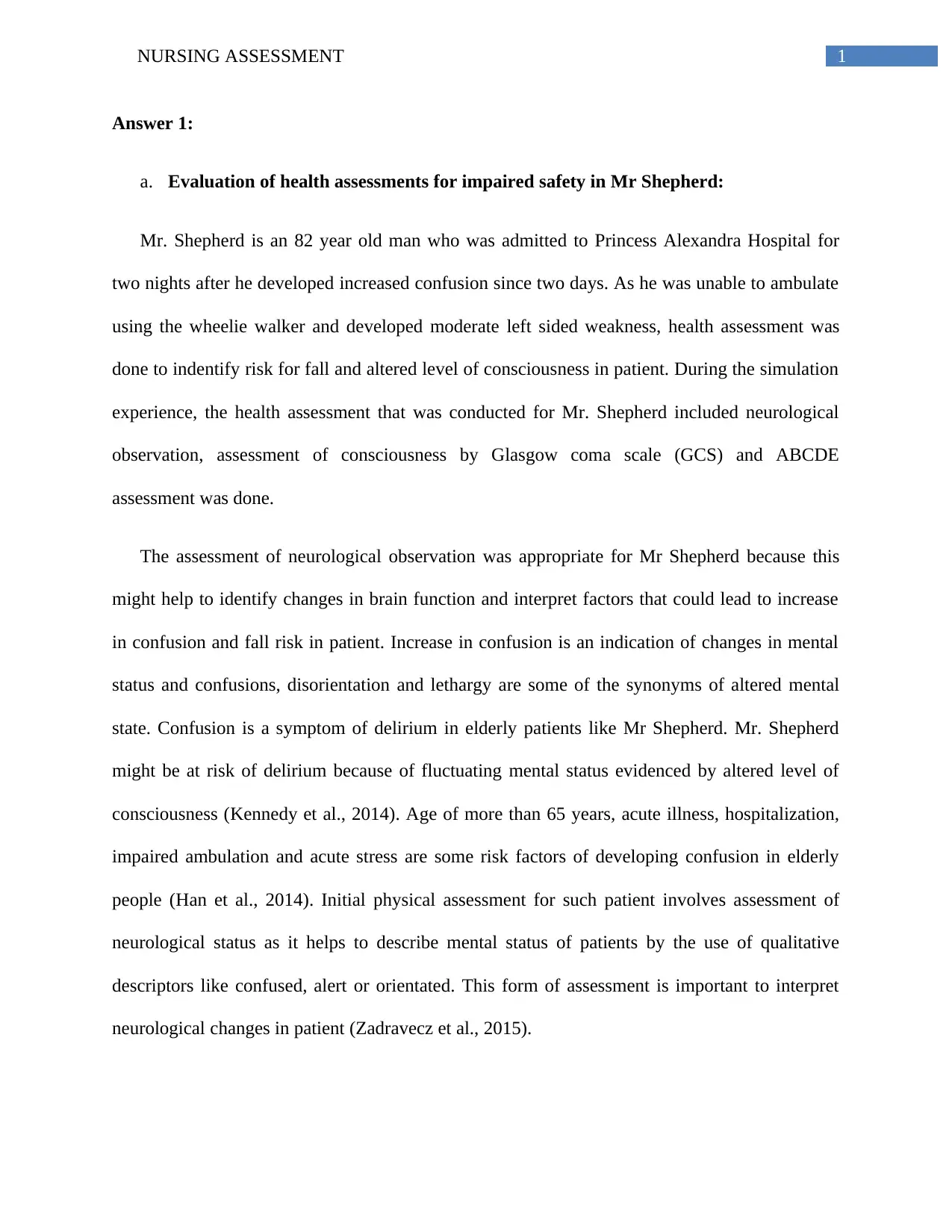
1NURSING ASSESSMENT
Answer 1:
a. Evaluation of health assessments for impaired safety in Mr Shepherd:
Mr. Shepherd is an 82 year old man who was admitted to Princess Alexandra Hospital for
two nights after he developed increased confusion since two days. As he was unable to ambulate
using the wheelie walker and developed moderate left sided weakness, health assessment was
done to indentify risk for fall and altered level of consciousness in patient. During the simulation
experience, the health assessment that was conducted for Mr. Shepherd included neurological
observation, assessment of consciousness by Glasgow coma scale (GCS) and ABCDE
assessment was done.
The assessment of neurological observation was appropriate for Mr Shepherd because this
might help to identify changes in brain function and interpret factors that could lead to increase
in confusion and fall risk in patient. Increase in confusion is an indication of changes in mental
status and confusions, disorientation and lethargy are some of the synonyms of altered mental
state. Confusion is a symptom of delirium in elderly patients like Mr Shepherd. Mr. Shepherd
might be at risk of delirium because of fluctuating mental status evidenced by altered level of
consciousness (Kennedy et al., 2014). Age of more than 65 years, acute illness, hospitalization,
impaired ambulation and acute stress are some risk factors of developing confusion in elderly
people (Han et al., 2014). Initial physical assessment for such patient involves assessment of
neurological status as it helps to describe mental status of patients by the use of qualitative
descriptors like confused, alert or orientated. This form of assessment is important to interpret
neurological changes in patient (Zadravecz et al., 2015).
Answer 1:
a. Evaluation of health assessments for impaired safety in Mr Shepherd:
Mr. Shepherd is an 82 year old man who was admitted to Princess Alexandra Hospital for
two nights after he developed increased confusion since two days. As he was unable to ambulate
using the wheelie walker and developed moderate left sided weakness, health assessment was
done to indentify risk for fall and altered level of consciousness in patient. During the simulation
experience, the health assessment that was conducted for Mr. Shepherd included neurological
observation, assessment of consciousness by Glasgow coma scale (GCS) and ABCDE
assessment was done.
The assessment of neurological observation was appropriate for Mr Shepherd because this
might help to identify changes in brain function and interpret factors that could lead to increase
in confusion and fall risk in patient. Increase in confusion is an indication of changes in mental
status and confusions, disorientation and lethargy are some of the synonyms of altered mental
state. Confusion is a symptom of delirium in elderly patients like Mr Shepherd. Mr. Shepherd
might be at risk of delirium because of fluctuating mental status evidenced by altered level of
consciousness (Kennedy et al., 2014). Age of more than 65 years, acute illness, hospitalization,
impaired ambulation and acute stress are some risk factors of developing confusion in elderly
people (Han et al., 2014). Initial physical assessment for such patient involves assessment of
neurological status as it helps to describe mental status of patients by the use of qualitative
descriptors like confused, alert or orientated. This form of assessment is important to interpret
neurological changes in patient (Zadravecz et al., 2015).

2NURSING ASSESSMENT
Altered mental status is one of the common causes of hospital admission. Han et al. (2014)
justified the use of GCS as it can provide clues to the etiology of altered mental state. It is mainly
done with the use of GCS to interpret verbal, motor and eye-opening response in patient. The
three categories mentioned in GCS pertain to different areas of conscious state. As it was
originally developed to evaluate conscious state of patient after traumatic brain injury, it’s use is
justified whenever there is a need to evaluate conscious state of a person. In addition, ABCDE is
a useful approach during initial assessment of patient to understand risk factors behind fall
(Chikura, Conroy & Salvi, 2018).
b. Additional health assessment data needed for the patients:
For Mr. Shepherd, health assessment for fall risk was identified by means of neurological
observation using GCS scale. However, as fall risk and altered mental status is associated with
changes in gait, mobility and balance, there was a need to conduct Timed Up-and-Go Test for
patient. It is a commonly used screening tool for fall risk in the inpatient setting. The patient is
time while they rise from an arm chair, walk on the floor and walk back to the chair and settle
down again. During the test, patients are supposed to use their regular footwear and walking aid.
Faster time is indicative of better functional performance, whereas timing of ≥13.5 seconds is
used to identify those at increased risk of fall (Barry et al., 2014). Kang et al. (2017) justified that
gait instability is a risk factor for falls and the Timed Up and Go Test is a validated tool to
evaluate people who are at risk of fall. After adjusting for age and gender, cutoff value of 15.96
seconds is predictive of recurrent falls in elderly population.
c. Goal for care and two nursing actions for the patient:
Altered mental status is one of the common causes of hospital admission. Han et al. (2014)
justified the use of GCS as it can provide clues to the etiology of altered mental state. It is mainly
done with the use of GCS to interpret verbal, motor and eye-opening response in patient. The
three categories mentioned in GCS pertain to different areas of conscious state. As it was
originally developed to evaluate conscious state of patient after traumatic brain injury, it’s use is
justified whenever there is a need to evaluate conscious state of a person. In addition, ABCDE is
a useful approach during initial assessment of patient to understand risk factors behind fall
(Chikura, Conroy & Salvi, 2018).
b. Additional health assessment data needed for the patients:
For Mr. Shepherd, health assessment for fall risk was identified by means of neurological
observation using GCS scale. However, as fall risk and altered mental status is associated with
changes in gait, mobility and balance, there was a need to conduct Timed Up-and-Go Test for
patient. It is a commonly used screening tool for fall risk in the inpatient setting. The patient is
time while they rise from an arm chair, walk on the floor and walk back to the chair and settle
down again. During the test, patients are supposed to use their regular footwear and walking aid.
Faster time is indicative of better functional performance, whereas timing of ≥13.5 seconds is
used to identify those at increased risk of fall (Barry et al., 2014). Kang et al. (2017) justified that
gait instability is a risk factor for falls and the Timed Up and Go Test is a validated tool to
evaluate people who are at risk of fall. After adjusting for age and gender, cutoff value of 15.96
seconds is predictive of recurrent falls in elderly population.
c. Goal for care and two nursing actions for the patient:
⊘ This is a preview!⊘
Do you want full access?
Subscribe today to unlock all pages.

Trusted by 1+ million students worldwide
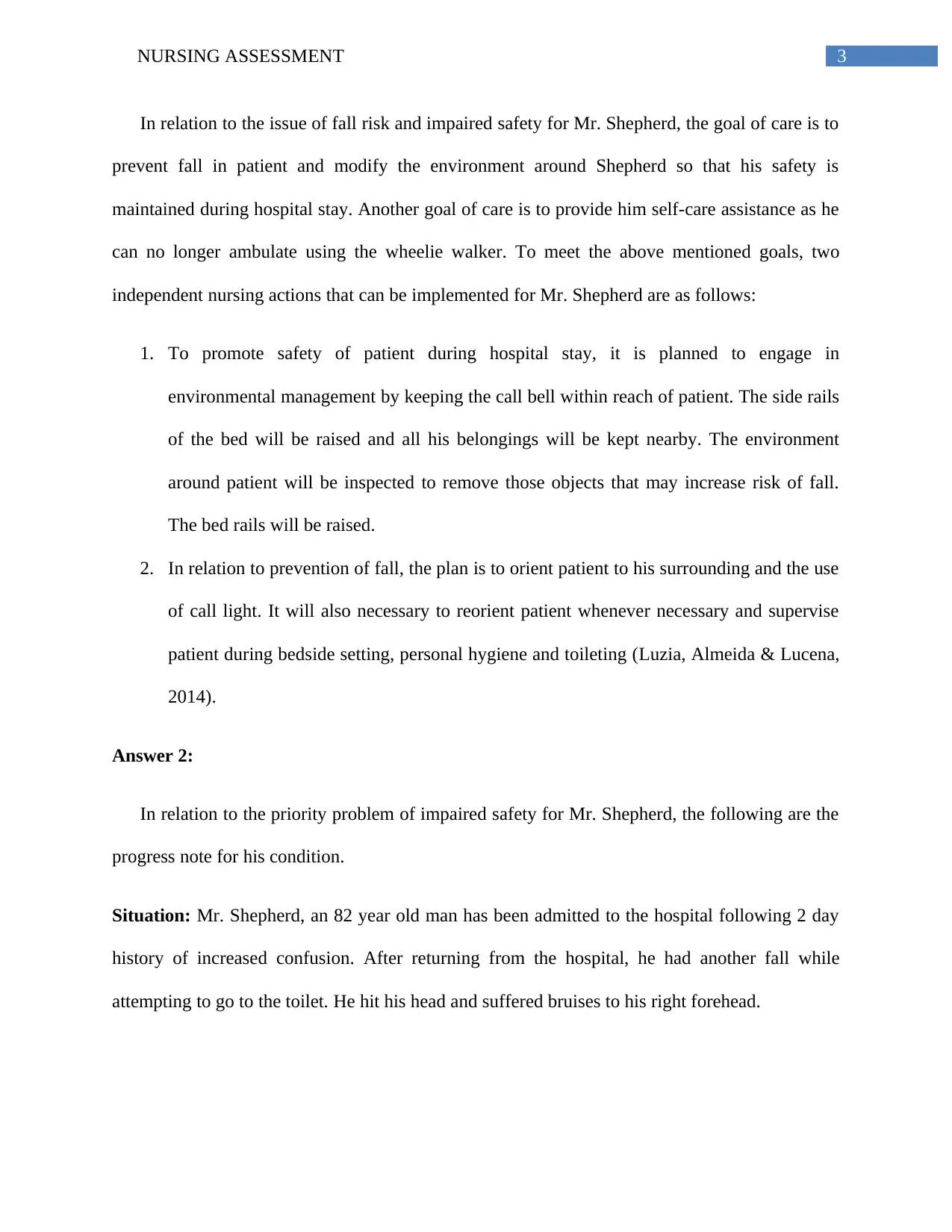
3NURSING ASSESSMENT
In relation to the issue of fall risk and impaired safety for Mr. Shepherd, the goal of care is to
prevent fall in patient and modify the environment around Shepherd so that his safety is
maintained during hospital stay. Another goal of care is to provide him self-care assistance as he
can no longer ambulate using the wheelie walker. To meet the above mentioned goals, two
independent nursing actions that can be implemented for Mr. Shepherd are as follows:
1. To promote safety of patient during hospital stay, it is planned to engage in
environmental management by keeping the call bell within reach of patient. The side rails
of the bed will be raised and all his belongings will be kept nearby. The environment
around patient will be inspected to remove those objects that may increase risk of fall.
The bed rails will be raised.
2. In relation to prevention of fall, the plan is to orient patient to his surrounding and the use
of call light. It will also necessary to reorient patient whenever necessary and supervise
patient during bedside setting, personal hygiene and toileting (Luzia, Almeida & Lucena,
2014).
Answer 2:
In relation to the priority problem of impaired safety for Mr. Shepherd, the following are the
progress note for his condition.
Situation: Mr. Shepherd, an 82 year old man has been admitted to the hospital following 2 day
history of increased confusion. After returning from the hospital, he had another fall while
attempting to go to the toilet. He hit his head and suffered bruises to his right forehead.
In relation to the issue of fall risk and impaired safety for Mr. Shepherd, the goal of care is to
prevent fall in patient and modify the environment around Shepherd so that his safety is
maintained during hospital stay. Another goal of care is to provide him self-care assistance as he
can no longer ambulate using the wheelie walker. To meet the above mentioned goals, two
independent nursing actions that can be implemented for Mr. Shepherd are as follows:
1. To promote safety of patient during hospital stay, it is planned to engage in
environmental management by keeping the call bell within reach of patient. The side rails
of the bed will be raised and all his belongings will be kept nearby. The environment
around patient will be inspected to remove those objects that may increase risk of fall.
The bed rails will be raised.
2. In relation to prevention of fall, the plan is to orient patient to his surrounding and the use
of call light. It will also necessary to reorient patient whenever necessary and supervise
patient during bedside setting, personal hygiene and toileting (Luzia, Almeida & Lucena,
2014).
Answer 2:
In relation to the priority problem of impaired safety for Mr. Shepherd, the following are the
progress note for his condition.
Situation: Mr. Shepherd, an 82 year old man has been admitted to the hospital following 2 day
history of increased confusion. After returning from the hospital, he had another fall while
attempting to go to the toilet. He hit his head and suffered bruises to his right forehead.
Paraphrase This Document
Need a fresh take? Get an instant paraphrase of this document with our AI Paraphraser
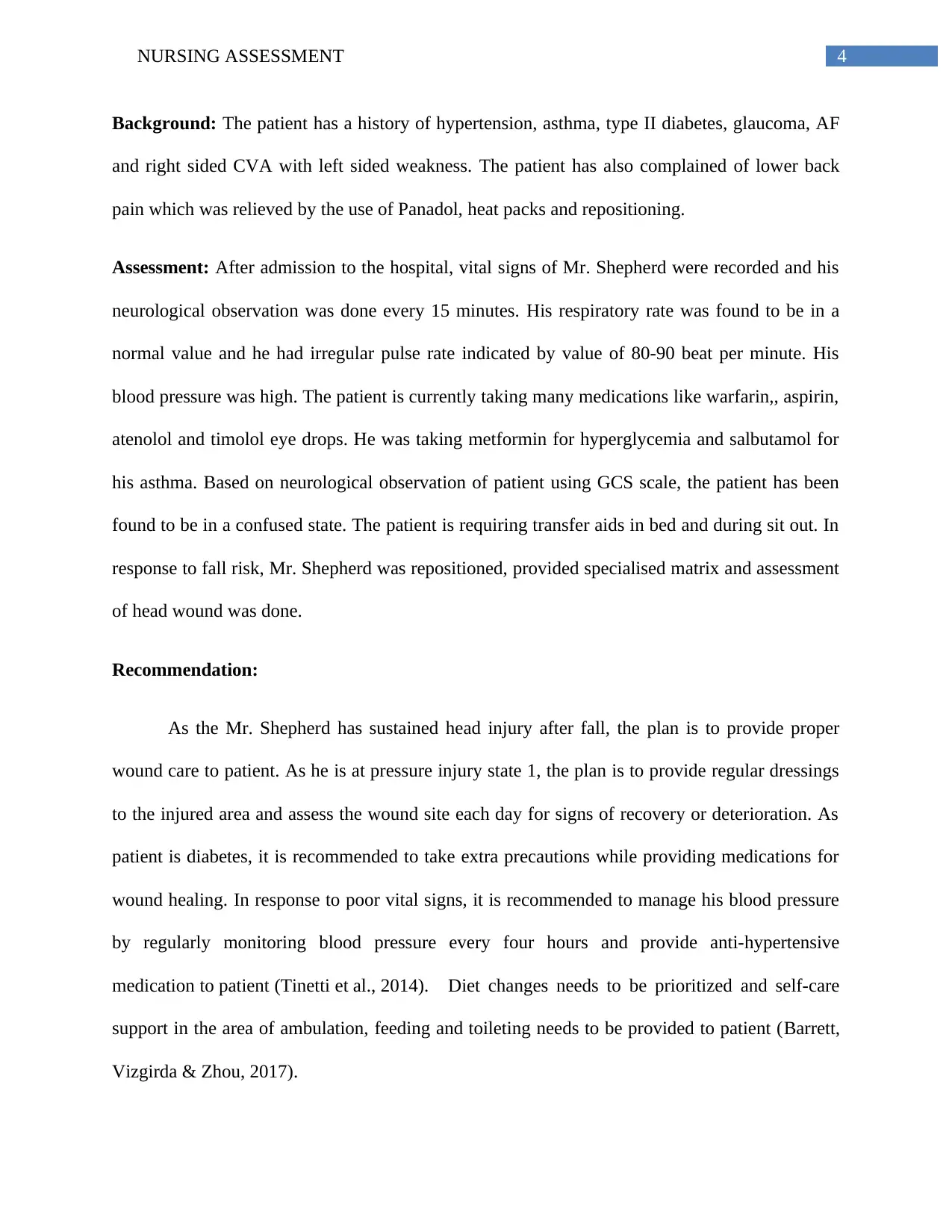
4NURSING ASSESSMENT
Background: The patient has a history of hypertension, asthma, type II diabetes, glaucoma, AF
and right sided CVA with left sided weakness. The patient has also complained of lower back
pain which was relieved by the use of Panadol, heat packs and repositioning.
Assessment: After admission to the hospital, vital signs of Mr. Shepherd were recorded and his
neurological observation was done every 15 minutes. His respiratory rate was found to be in a
normal value and he had irregular pulse rate indicated by value of 80-90 beat per minute. His
blood pressure was high. The patient is currently taking many medications like warfarin,, aspirin,
atenolol and timolol eye drops. He was taking metformin for hyperglycemia and salbutamol for
his asthma. Based on neurological observation of patient using GCS scale, the patient has been
found to be in a confused state. The patient is requiring transfer aids in bed and during sit out. In
response to fall risk, Mr. Shepherd was repositioned, provided specialised matrix and assessment
of head wound was done.
Recommendation:
As the Mr. Shepherd has sustained head injury after fall, the plan is to provide proper
wound care to patient. As he is at pressure injury state 1, the plan is to provide regular dressings
to the injured area and assess the wound site each day for signs of recovery or deterioration. As
patient is diabetes, it is recommended to take extra precautions while providing medications for
wound healing. In response to poor vital signs, it is recommended to manage his blood pressure
by regularly monitoring blood pressure every four hours and provide anti-hypertensive
medication to patient (Tinetti et al., 2014). Diet changes needs to be prioritized and self-care
support in the area of ambulation, feeding and toileting needs to be provided to patient (Barrett,
Vizgirda & Zhou, 2017).
Background: The patient has a history of hypertension, asthma, type II diabetes, glaucoma, AF
and right sided CVA with left sided weakness. The patient has also complained of lower back
pain which was relieved by the use of Panadol, heat packs and repositioning.
Assessment: After admission to the hospital, vital signs of Mr. Shepherd were recorded and his
neurological observation was done every 15 minutes. His respiratory rate was found to be in a
normal value and he had irregular pulse rate indicated by value of 80-90 beat per minute. His
blood pressure was high. The patient is currently taking many medications like warfarin,, aspirin,
atenolol and timolol eye drops. He was taking metformin for hyperglycemia and salbutamol for
his asthma. Based on neurological observation of patient using GCS scale, the patient has been
found to be in a confused state. The patient is requiring transfer aids in bed and during sit out. In
response to fall risk, Mr. Shepherd was repositioned, provided specialised matrix and assessment
of head wound was done.
Recommendation:
As the Mr. Shepherd has sustained head injury after fall, the plan is to provide proper
wound care to patient. As he is at pressure injury state 1, the plan is to provide regular dressings
to the injured area and assess the wound site each day for signs of recovery or deterioration. As
patient is diabetes, it is recommended to take extra precautions while providing medications for
wound healing. In response to poor vital signs, it is recommended to manage his blood pressure
by regularly monitoring blood pressure every four hours and provide anti-hypertensive
medication to patient (Tinetti et al., 2014). Diet changes needs to be prioritized and self-care
support in the area of ambulation, feeding and toileting needs to be provided to patient (Barrett,
Vizgirda & Zhou, 2017).
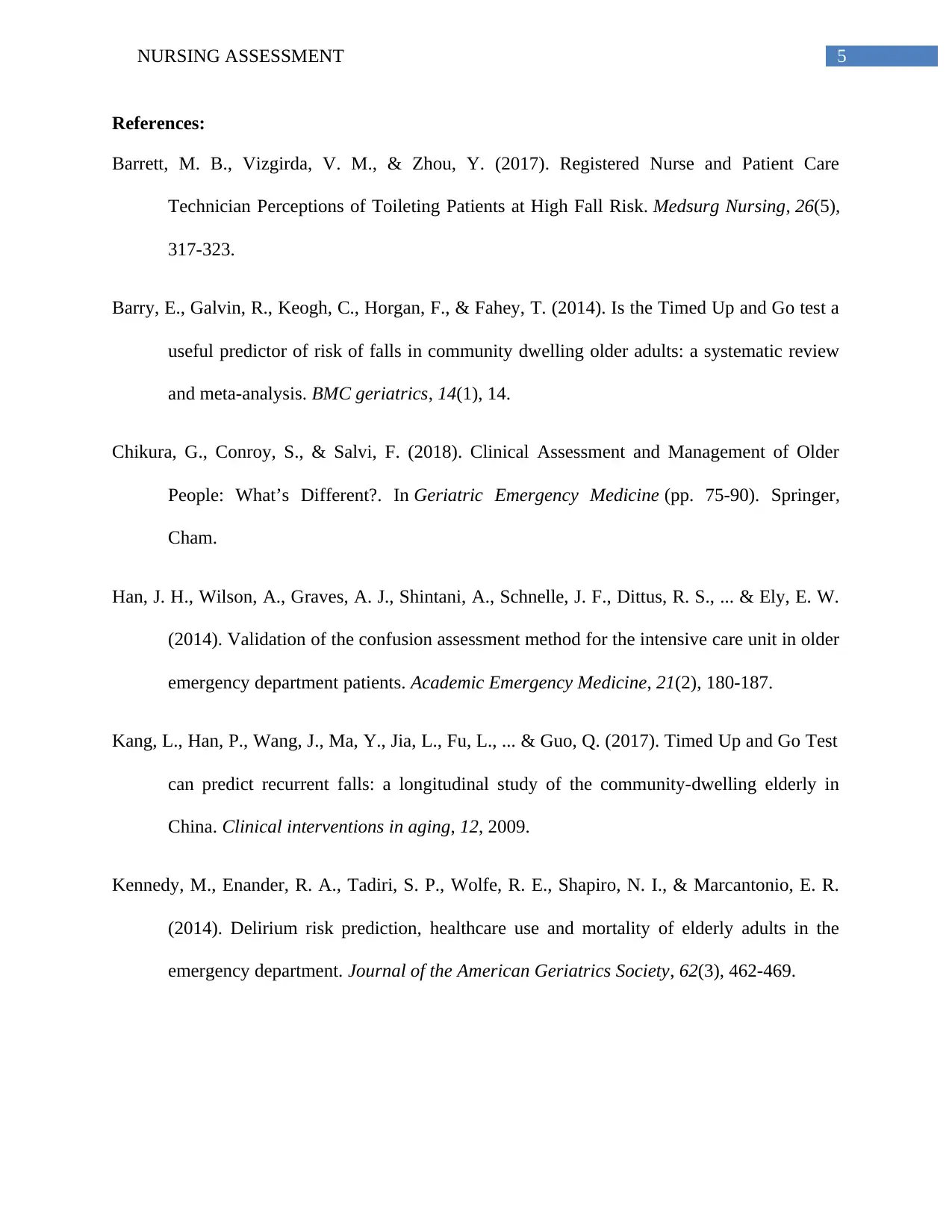
5NURSING ASSESSMENT
References:
Barrett, M. B., Vizgirda, V. M., & Zhou, Y. (2017). Registered Nurse and Patient Care
Technician Perceptions of Toileting Patients at High Fall Risk. Medsurg Nursing, 26(5),
317-323.
Barry, E., Galvin, R., Keogh, C., Horgan, F., & Fahey, T. (2014). Is the Timed Up and Go test a
useful predictor of risk of falls in community dwelling older adults: a systematic review
and meta-analysis. BMC geriatrics, 14(1), 14.
Chikura, G., Conroy, S., & Salvi, F. (2018). Clinical Assessment and Management of Older
People: What’s Different?. In Geriatric Emergency Medicine (pp. 75-90). Springer,
Cham.
Han, J. H., Wilson, A., Graves, A. J., Shintani, A., Schnelle, J. F., Dittus, R. S., ... & Ely, E. W.
(2014). Validation of the confusion assessment method for the intensive care unit in older
emergency department patients. Academic Emergency Medicine, 21(2), 180-187.
Kang, L., Han, P., Wang, J., Ma, Y., Jia, L., Fu, L., ... & Guo, Q. (2017). Timed Up and Go Test
can predict recurrent falls: a longitudinal study of the community-dwelling elderly in
China. Clinical interventions in aging, 12, 2009.
Kennedy, M., Enander, R. A., Tadiri, S. P., Wolfe, R. E., Shapiro, N. I., & Marcantonio, E. R.
(2014). Delirium risk prediction, healthcare use and mortality of elderly adults in the
emergency department. Journal of the American Geriatrics Society, 62(3), 462-469.
References:
Barrett, M. B., Vizgirda, V. M., & Zhou, Y. (2017). Registered Nurse and Patient Care
Technician Perceptions of Toileting Patients at High Fall Risk. Medsurg Nursing, 26(5),
317-323.
Barry, E., Galvin, R., Keogh, C., Horgan, F., & Fahey, T. (2014). Is the Timed Up and Go test a
useful predictor of risk of falls in community dwelling older adults: a systematic review
and meta-analysis. BMC geriatrics, 14(1), 14.
Chikura, G., Conroy, S., & Salvi, F. (2018). Clinical Assessment and Management of Older
People: What’s Different?. In Geriatric Emergency Medicine (pp. 75-90). Springer,
Cham.
Han, J. H., Wilson, A., Graves, A. J., Shintani, A., Schnelle, J. F., Dittus, R. S., ... & Ely, E. W.
(2014). Validation of the confusion assessment method for the intensive care unit in older
emergency department patients. Academic Emergency Medicine, 21(2), 180-187.
Kang, L., Han, P., Wang, J., Ma, Y., Jia, L., Fu, L., ... & Guo, Q. (2017). Timed Up and Go Test
can predict recurrent falls: a longitudinal study of the community-dwelling elderly in
China. Clinical interventions in aging, 12, 2009.
Kennedy, M., Enander, R. A., Tadiri, S. P., Wolfe, R. E., Shapiro, N. I., & Marcantonio, E. R.
(2014). Delirium risk prediction, healthcare use and mortality of elderly adults in the
emergency department. Journal of the American Geriatrics Society, 62(3), 462-469.
⊘ This is a preview!⊘
Do you want full access?
Subscribe today to unlock all pages.

Trusted by 1+ million students worldwide

6NURSING ASSESSMENT
Luzia, M. D. F., Almeida, M. D. A., & Lucena, A. D. F. (2014). Nursing care mapping for
patients at risk of falls in the Nursing Interventions Classification. Revista da Escola de
Enfermagem da USP, 48(4), 632-640.
Tinetti, M. E., Han, L., Lee, D. S., McAvay, G. J., Peduzzi, P., Gross, C. P., ... & Lin, H. (2014).
Antihypertensive medications and serious fall injuries in a nationally representative
sample of older adults. JAMA internal medicine, 174(4), 588-595.
Zadravecz, F. J., Tien, L., Robertson‐Dick, B. J., Yuen, T. C., Twu, N. M., Churpek, M. M., &
Edelson, D. P. (2015). Comparison of mental‐status scales for predicting mortality on the
general wards. Journal of hospital medicine, 10(10), 658-663.
Luzia, M. D. F., Almeida, M. D. A., & Lucena, A. D. F. (2014). Nursing care mapping for
patients at risk of falls in the Nursing Interventions Classification. Revista da Escola de
Enfermagem da USP, 48(4), 632-640.
Tinetti, M. E., Han, L., Lee, D. S., McAvay, G. J., Peduzzi, P., Gross, C. P., ... & Lin, H. (2014).
Antihypertensive medications and serious fall injuries in a nationally representative
sample of older adults. JAMA internal medicine, 174(4), 588-595.
Zadravecz, F. J., Tien, L., Robertson‐Dick, B. J., Yuen, T. C., Twu, N. M., Churpek, M. M., &
Edelson, D. P. (2015). Comparison of mental‐status scales for predicting mortality on the
general wards. Journal of hospital medicine, 10(10), 658-663.
1 out of 7
Related Documents
Your All-in-One AI-Powered Toolkit for Academic Success.
+13062052269
info@desklib.com
Available 24*7 on WhatsApp / Email
![[object Object]](/_next/static/media/star-bottom.7253800d.svg)
Unlock your academic potential
Copyright © 2020–2025 A2Z Services. All Rights Reserved. Developed and managed by ZUCOL.





